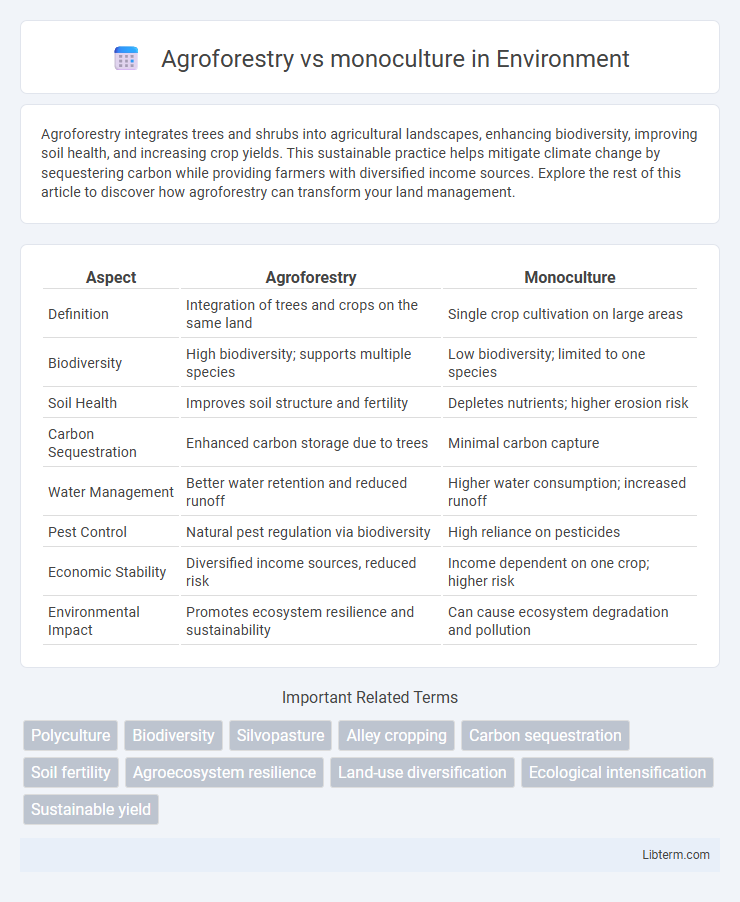Agroforestry integrates trees and shrubs into agricultural landscapes, enhancing biodiversity, improving soil health, and increasing crop yields. This sustainable practice helps mitigate climate change by sequestering carbon while providing farmers with diversified income sources. Explore the rest of this article to discover how agroforestry can transform your land management.
Table of Comparison
| Aspect | Agroforestry | Monoculture |
|---|---|---|
| Definition | Integration of trees and crops on the same land | Single crop cultivation on large areas |
| Biodiversity | High biodiversity; supports multiple species | Low biodiversity; limited to one species |
| Soil Health | Improves soil structure and fertility | Depletes nutrients; higher erosion risk |
| Carbon Sequestration | Enhanced carbon storage due to trees | Minimal carbon capture |
| Water Management | Better water retention and reduced runoff | Higher water consumption; increased runoff |
| Pest Control | Natural pest regulation via biodiversity | High reliance on pesticides |
| Economic Stability | Diversified income sources, reduced risk | Income dependent on one crop; higher risk |
| Environmental Impact | Promotes ecosystem resilience and sustainability | Can cause ecosystem degradation and pollution |
Introduction to Agroforestry and Monoculture
Agroforestry integrates trees and shrubs into crop and livestock systems, enhancing biodiversity, improving soil health, and increasing carbon sequestration compared to monoculture, which involves cultivating a single crop over a large area. Monoculture simplifies management and maximizes short-term yield but often leads to soil degradation, increased pest vulnerability, and reduced ecosystem resilience. Agroforestry's diversified approach supports sustainable agriculture by promoting ecological balance and long-term productivity.
Defining Agroforestry: Principles and Practices
Agroforestry integrates trees and shrubs into crop and livestock systems, promoting biodiversity and sustainable land use. Key principles include combining species for mutual benefits, enhancing soil health, and improving water retention. Practices such as alley cropping, silvopasture, and forest farming optimize resource use and increase farm resilience compared to monoculture systems.
Understanding Monoculture: Characteristics and Methods
Monoculture involves cultivating a single crop species on a particular land area, often emphasizing uniformity and maximizing short-term yields. This agricultural method relies heavily on chemical inputs such as fertilizers and pesticides to maintain productivity and control pests. Characteristics include simplified ecosystem structures, increased vulnerability to diseases, and soil degradation risks due to lack of biodiversity.
Biodiversity: Comparing Ecosystem Impacts
Agroforestry enhances biodiversity by integrating trees, crops, and livestock, creating complex habitats that support diverse flora and fauna. In contrast, monoculture simplifies ecosystems, reducing species richness and altering soil health negatively. Studies show agroforestry systems increase pollinator populations and improve pest regulation, promoting ecosystem resilience.
Soil Health and Fertility in Both Systems
Agroforestry enhances soil health by promoting biodiversity, improving organic matter content, and increasing nutrient cycling through diverse plant species and root structures, leading to better soil fertility. In contrast, monoculture often depletes soil nutrients rapidly due to continuous planting of a single crop, resulting in soil degradation and increased reliance on chemical fertilizers. Agroforestry systems reduce erosion and improve soil structure, while monoculture practices contribute to soil compaction and reduced microbial activity.
Water Management and Conservation Differences
Agroforestry integrates trees with crops or livestock to enhance water retention and reduce surface runoff, improving groundwater recharge and soil moisture conservation compared to monoculture systems. Monoculture often leads to increased soil erosion and faster water depletion due to uniform crop rooting depths and lack of vegetative diversity. The multilayered canopy in agroforestry systems increases rainwater infiltration and minimizes evaporation, promoting sustainable water management and conservation.
Climate Change Mitigation: Carbon Sequestration
Agroforestry systems enhance carbon sequestration by integrating trees with crops, increasing biomass and soil organic carbon storage, which significantly reduces atmospheric CO2 levels. Monoculture practices typically sequester less carbon due to lower biodiversity and single-crop biomass, resulting in diminished soil carbon accumulation and higher vulnerability to climate stress. Scientific studies show agroforestry can store up to 50% more carbon than conventional monoculture, making it a more effective strategy for climate change mitigation.
Economic Considerations: Yields and Profitability
Agroforestry systems diversify income by integrating trees with crops or livestock, often leading to more stable and resilient yields compared to monoculture. The diversification reduces economic risks associated with market fluctuations and crop failure, enhancing long-term profitability. Monoculture can offer higher short-term yields per crop but remains vulnerable to pests and diseases, potentially reducing economic sustainability.
Challenges and Limitations of Each Approach
Agroforestry faces challenges like complex management requirements, higher initial labor and investment costs, and potential competition between tree and crop species for water and nutrients. Monoculture systems often suffer from soil degradation, reduced biodiversity, increased vulnerability to pests and diseases, and dependency on chemical fertilizers and pesticides. Both approaches demand careful consideration of ecological balance and long-term sustainability to mitigate these limitations effectively.
Future Perspectives: Sustainable Agriculture Practices
Agroforestry presents a promising future for sustainable agriculture by enhancing biodiversity, improving soil health, and increasing carbon sequestration compared to monoculture systems. Integrating trees with crops and livestock fosters resilience against climate change and reduces dependency on synthetic inputs. Future agricultural models emphasize agroforestry for sustainable food production, ecosystem restoration, and long-term environmental stability.
Agroforestry Infographic

 libterm.com
libterm.com